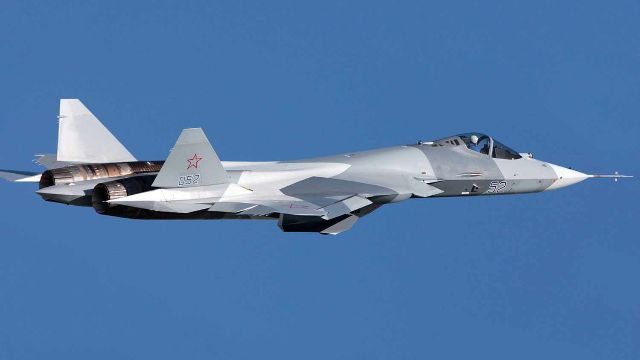Alaska, the northernmost U.S. state, plays a crucial role in national security due to its location near the Arctic and its close proximity to Russia. Alaska is only 55 miles from Russian territory at its closest point.
Alaska’s Strategic Role and Growing Vulnerabilities
Because of this, Alaska has long been a key defense zone, especially during the Cold War when radar sites and air bases were built to detect enemy aircraft. Today, that strategic importance has resurfaced with the appearance of advanced Russian fighter jets like the Su-57 near Alaskan airspace, raising new concerns about air defense readiness in the region.
Important American military outposts, such as Eielson Air Force Base and Joint Base Elmendorf-Richardson, are still located in Alaska today. These sites fly cutting-edge fighter jets, such as the F-35 Lightning II and F-22 Raptor. The protection of American airspace in the area is the responsibility of these jets. But defensive measures are difficult and occasionally slow due to Alaska’s enormous size—more than 660,000 square miles—and its severe Arctic climate.
Russian military analysts have pointed up a flaw in the American air defense system in Alaska. They focused on the cancellation of the E-7 Wedgetail aircraft program, which was supposed to replace the outdated E-3 Sentry radar aircraft. Without this upgrade, the U.S. could struggle to detect stealthy aircraft and missiles flying in the region. The older E-3 aircraft uses radar technology from the 1970s and needs frequent maintenance, making it less reliable for modern threats.
AI Co-Pilot in the Cockpit: Russia’s Su-57 Showcases Combat Autonomy Feature
The canceled E-7 aircraft featured an advanced radar system that could have covered large areas of airspace and detected threats from over 200 miles away. Losing this capability is seen by experts as a major setback, especially for monitoring vast and remote airspace like that over Alaska.
Su-57 Raises Tensions Near Alaskan Airspace
Concerns grew even further as Russian forces reportedly flew fifth-generation Su-57 fighter jets close to Alaskan airspace. These jets are among the most advanced in Russia’s arsenal. They use stealth technology to avoid radar detection. The Su-57 is also built to operate effectively in high-threat environments. The Su-57 has features like stealth design, powerful sensors, and the ability to fly at high speeds for long distances. These make it a strong competitor against U.S. jets.
Russian analysts assess that the Su-57 can protect or escort long-range bombers like the Tu-95 and Tu-160. These bombers have previously flown near Alaska and can carry both conventional and nuclear cruise missiles. They can strike targets over 1,500 miles away from their launch point.
Crippling US Sanctions Endanger SU-57 Fighter Jet Program of Russia
Analysts also believe the Su-57 performs better than its predecessor, the Su-35. It includes improvements like a smaller radar cross-section, better avionics, and superior sensors. These upgrades make it more difficult for U.S. defense systems to detect these aircraft. It is also harder to counter them effectively. The challenge is greater in areas where radar coverage is weak.
Russia has been conducting military patrols in the Arctic. It has also carried out several military exercises in the region. The presence of Su-57 jets near Alaska adds to these activities. Experts believe this development increases the risk. The combination of stealth bombers and advanced fighters could seriously challenge Alaska’s current air defense system.
Radar Shortfalls and the Su-57 Strategic Challenge
The absence of a modern early warning aircraft like the E-7 makes it harder for U.S. forces to detect fast-moving or stealth threats. Ground-based radars in Alaska, such as those operated by NORAD, are helpful but have limits due to the mountainous terrain and weather conditions. Satellite coverage helps too, but it’s not always real-time and may miss fast or low-flying aircraft.
Some efforts have been made to upgrade the existing E-3 aircraft or introduce unmanned surveillance planes. But these alternatives face technical problems and high costs. For instance, drones like the MQ-4C Triton are made for ocean surveillance and lack the strong radar needed for tracking aircraft over land.
Russia is not the only country increasing its activity in the Arctic. China has also shown interest by conducting joint military exercises with Russia and building long-range bombers like the H-6K. China’s aircraft currently do not have the same global range as Russia’s. However, the two countries are increasing their military cooperation.
India Eyes 5th-Gen Fighter Jet Amid Regional Tensions — F-35 or Su-57 on Radar
The growing partnership between Russia and China could create complex challenges for U.S. defenses. Analysts suggest that joint air missions involving Russian bombers and Chinese aircraft may approach Alaska from different directions, straining American detection and interception systems. Chinese bombers could enter from the west via the Russian Far East, while Russian jets may approach from the north.
This multi-directional threat would stretch U.S. response capabilities, especially given Alaska’s vast terrain, limited radar coverage, and difficult weather. Without modern airborne radar systems, Alaska may struggle to react swiftly to airspace violations, making it increasingly vulnerable despite its strategic importance.

